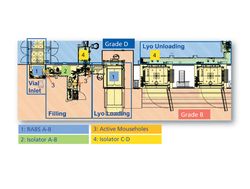
OR WAIT null SECS
- About Us
- Advertise
- Contact Us
- Editorial Info
- Editorial Contacts
- Editorial Advisory Board
- Do Not Sell My Personal Information
- Privacy Policy
- Terms and Conditions
© 2024 MJH Life Sciences™ and Pharmaceutical Technology. All rights reserved.
Using 3D Printing for Solid-Dosage Drugs
Equipment and Processing Report
Three-dimensional printing allows unique benefits to be built into solid-dosage forms.
Three-dimensional printing (3DP) is sometimes called additive manufacturing because it involves precisely adding layer on top of layer to build a 3D object. In discussions in the pharmaceutical industry, 3DP is often linked to personalized medicine. Indeed, 3DP is being used to manufacture medical devices-such as implants and prosthetics-designed for a specific person (1, 2), and FDA’s May 2016 draft guidance on additive manufactured devices includes direction for patient-matched devices (3). Academic researchers are investigating 3DP for printing living cells and organs (4). And researchers at the National University of Singapore envision 3D printing of customized, solid-dosage drugs that can combine multiple types of drugs and different release rates (5).
A host of challenges, including regulatory and technical issues, must be addressed before personalized, 3D-printed pills can be commercialized, perhaps some time in the future. Today, however, 3DP is being used by Aprecia Pharmaceuticals as a technique for cGMP manufacturing of commercial, solid-dosage drugs marketed through the conventional, FDA-approved regulatory path.
Aprecia’s ZipDose Technology
Aprecia’s Spritam (levetiracetam) tablets for oral suspension for treatment of seizures in adults and children with certain types of epilepsy became the first 3D-printed drug approved by FDA in August 2015 (6). The drug is made using the company’s proprietary ZipDose Technology platform, which it developed from 3DP technology originated at the Massachusetts Institute of Technology. The initial focus for the technology is to produce high-dose medications in a rapidly disintegrating, easy-to-swallow form.
“ZipDose is both a formulation platform and process for manufacturing,” says Jennifer Zieverink, senior director of marketing and alliance management at Aprecia. “The three primary benefits we see are the rapid disintegration in the mouth with a sip of liquid, along with taste-masking ability and high drug load. When we look across the landscape of central-nervous system drugs, we see that typically a high-drug dose is needed, often in a large pill that needs to be swallowed intact. Some patients struggle to swallow their medication, however, either due to the size of the pill or due to comorbid conditions associated with their medical issues. In this therapeutic area, we feel there is an opportunity to meet patient needs with a new dosing option.”
Other fast-melt dosage forms typically range from 50–200 mg of drug load, notes Zieverink. “Spritam is approved and being manufactured up to 1000 mg, and the manufacturing process is capable of going beyond that.”
Taste masking is easily incorporated in this process. “With a drug that disintegrates rapidly in the mouth, there is a need to neutralize the bitter API taste or even add pleasant taste. Currently we use a spearmint flavor to neutralize the tastes, but in the future could consider other types. The nature of the 3DP process gives a lot of room for adding taste masking. We can even wrap API for extended release, which is in development,” says Zieverink.
Powder-liquid 3DP
“In our 3D printing process, we put down thin layers of powdered active-ingredient blends, then we spray or ‘print’ liquid onto each layer. The interactions between the particles and the liquid is what creates our tablet structure,” explains Grant Brock, vice-president of engineering at Aprecia. The resulting tablet is very porous, which allows it to disintegrate prior to swallowing. The porous structure is partly due to the fact that the process does not rely on the compression forces used to make traditional tablets.
One of the drawbacks often noted for 3DP in various industries is a smaller scale with lower output than the corresponding traditional manufacturing method. Aprecia notes that their process has some limits, but that their engineers have “jumped the hurdle of manufacturing at commercial scale,” says Zieverink, while achieving the benefit of the precision manufacturing of 3DP manufacturing.
“Our equipment and process has been designed for commercial scale. Our process is really a unique technology using 3DP capabilities but in a custom platform; we produce at tens of thousands of doses per hour,” adds Brock. Because this is still a new technology, greater efficiency may be achieved as the technology evolves. “Continuous improvement is in our DNA. We’ll always be looking at ways to improve our capacity, efficiency, and throughput,” says Brock.
Personalized medicine and 3DP
Although 3DP is often associated with personalized medicine, the FDA-approved drugs made by Aprecia are not personalized; they are made using a commercial-scale, CGMP process and distributed through traditional methods. “Personalized medicine-someone intervening in the manufacture of a drug-is not in the regulatory pathway at this point in time for this manufacturing process. It is a worthy endeavour, but it is years away. Our current process is not used for personalized medicine or printing on demand or printing at home,” notes Zieverink. “With our 3DP platform, we are focused on a unique administration experience-disintegration in the mouth and taste masking-combined with high drug load. However, what’s not different from traditional solid-dosage drugs is that this is a highly regulated process used to make a FDA-approved drug, Spritam, available in specific strengths: 250, 500, 750, and 1000 mg, which are the same strengths as the tablets that are available. We have traditional distribution methods through retail pharmacy, and the patient must get a prescription from his or her physician.”
Future goals
Aprecia is currently manufacturing only in the US, but is actively evaluating opportunities for manufacturing in other regions. The company has initially focused on central nervous system (CNS) drugs, but says that their process could be applicable to other areas or in the veterinary drug space. “We have more CNS drugs in the pipeline, but as we ramp up and grow we do see an opportunity to branch out across therapeutic areas in the future,” says Zieverink.
References
- Oxford Performance Materials, “OPM Receives FDA Clearance for 3D Printed OsteoFab Patient-Specific Facial Device,” Press Release, Aug. 19, 2014.
- University of Michigan Health System, “3D-Airway Printed Splint,” https://medicine.umich.edu/dept/otolaryngology/3d-airway-printed-splint , accessed June 21, 2016.
- FDA, Draft Guidance for Industry and Food and Drug Administration Staff: Technical Considerations for Additive Manufactured Devices (Silver Spring, MD, May 10, 2016).
- Carnegie Mellon University College of Engineering, “Carnegie Mellon Researchers Hack Off-the-Shelf 3-D Printer Toward Rebuilding the Heart,” https://engineering.cmu.edu/media/feature/2015/10_23_feinberg_paper.html, accessed June 21, 2016.
- National University of Singapore, “NUS Engineering team develops novel technology to ‘print’ customised tablets for personalised medicine,” Press Release, May 25, 2016.
- Aprecia Pharmaceuticals, “FDA Approves the First 3D Printed Drug Product,” Press Release, August 3, 2015.
Freeform reversible embedding of suspended hydrogels (FRESH) is a method of three-dimensional (3D) printing of soft materials. “Most 3D printers on the market are good for printing metals, ceramics, or plastics, but soft materials (such as living cells) that collapse under their own weight have been challenging to 3D print,” explained Adam Feinberg, associate professor of Biomedical Engineering at Carnegie Mellon University, in an interview with Pharmaceutical Technology. His group has developed a technology to solve this problem by printing one gel inside of another support gel.
Thermal inkjet printers can be designed to print biomolecules. “Ink jet generates a little bit of heat to vaporize the liquid, but this can typically be tuned so that it doesn’t damage the biomolecules,” says Feinberg, and channels must be designed to be large enough to avoid excessive shear force.
In the future, 3D printing could be used to print complete organs. Along with the organ, a vascular-like fluid-transport network is required. “Vascularization is a challenge, because you need to have a system that can get nutrients within 100 to 200 microns of the cell. A lot of research is currently going into how to accomplish 3D printing of this system and linking it to the host during transplant,” says Feinberg.
For more information, watch a video interview with Feinberg at www.PharmTech.com/challenges-3d-bioprinting-0.
Citation:
When referring to this article, please cite it as J. Markarian, "Using 3D Printing for Solid-Dosage Drugs," Pharmaceutical Technology 40 (8) 2016.


